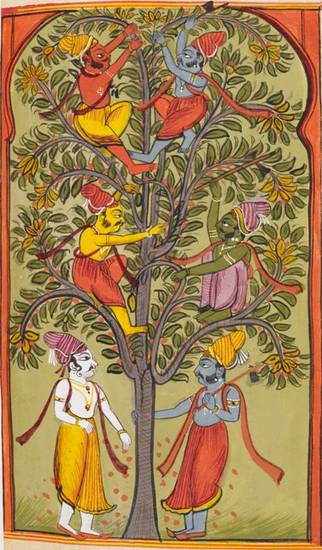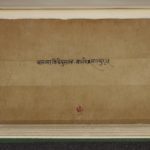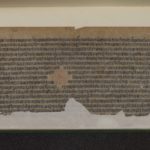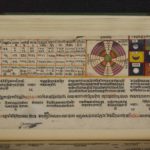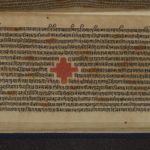Article: Highlights of JAINpedia
Many examples of remarkable manuscripts which Jains have copied or composed are digitised on the JAINpedia website. Articles in this section describe the contents of some of the individual texts available on JAINpedia.
Jain manuscripts capture religious teachings that have previously been passed on orally. Those that have survived date back to the 11th century or later. They are mostly written on palm leaf or paper, but other materials such as cloth are used as well. They also cover a wider range of needs, ranging from ceremonial procedures and philosophical treatises through stories and hymns to records of monastic lineages. Many manuscripts are also good examples of visual art, showing stylistic development in painting as well as conventional devices and patterns.
The digitised manuscripts on JAINpedia take several forms and are often lavishly illustrated. Scriptures preserve Jain religious beliefs and provide support for practices. A particularly interesting element of Jain doctrine is cosmology, the framework for important religious concepts such as the cycle of birth and karma. Embedding Jain values into stories has long been a popular method of passing on religious doctrine. These tales provide heroes and heroines for a minority group within Indian society and help create a Jain heritage. A key part of religious practice for Jains, hymns offer scope for both individual and community worship.
Sacred objects are also available on JAINpedia. Used in worship and meditation, items such as maṇḍalas, aḍhāī-dvīpas and victory banners are frequently artefacts of great artistic merit. Letters from lay Jains inviting mendicants for the rainy season have both practical and symbolic aspects, and are often beautiful objects.
Scriptures
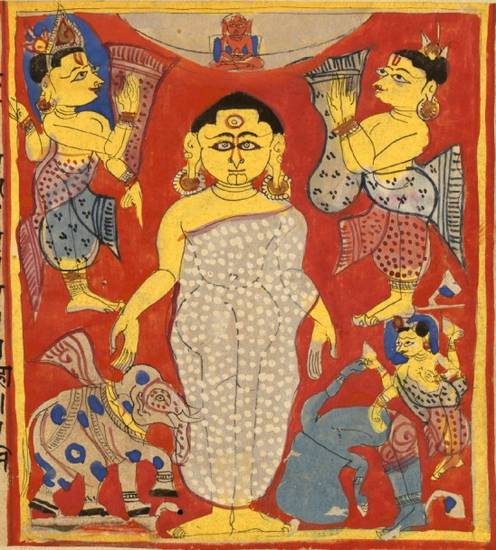
Right monastic behaviour
Image by Victoria and Albert Museum © V&A Images/Victoria and Albert Museum, London
Several key holy texts are highlights of the manuscripts on JAINpedia.
The Kalpa-sūtra is the best-known book of the Śvetāmbara sect. Written in Ardhamāgadhī Prakrit, the Kalpa-sūtra features:
- biographies of the Jinas
- lineages of early Jain teachers
- monastic rules for the rainy season.
It is surely the Jain work that has produced the largest amount of illustrated manuscripts. There are several examples on JAINpedia showing a variety of pictorial styles.
The British Library I.O. San. 3177 and the manuscript Gamma 453 in the Wellcome Library are remarkable specimens from the 15th century that use calligraphy, golden or silver ink, and coloured papers. In contrast, the manuscript Or. 13701 is an example of informal style with Mughal costumes and cursive script. All the other Kalpa-sūtras deserve interest in their own right as they are finely executed artefacts.
The Uttarādhyayana-sūtra is one of the most famous and fundamental books of the Śvetāmbara canon. In Ardhamāgadhī Prakrit, it contains both didactic and narrative material. It is one of the works that have developed an elaborate pictorial tradition. The two complete manuscripts of the Uttarādhyayana-sūtra digitised on JAINpedia offer remarkable paintings. Held by the British Library, the manuscript Or. 13362 and its counterpart in the Victoria and Albert Museum (V&A), with the shelfmark IS 2-1972, are powerful examples of Jain art.
The Āvaśyaka-sūtra, along with its commentary the Āvaśyaka-niryukti, holds central importance in the practice of Śvetāmbara Jains. It includes the:
- homage to the five entities – panca-namaskāra-mantra
- first hymn to the 24 Jinas
- core formulas recited during the repentance ritual – pratikramaṇa.
One of the JAINpedia manuscripts is from the 15th century, which is noteworthy as it is comparatively early. Found in the British Library, the Āvaśyaka-niryukti manuscript with the shelfmark Or. 13550 dates back to 1466.
Considered with its commentaries, the Jītakalpa-sūtra deals with monastic rules and atonements for transgressions. Such works are not commonly found in manuscripts kept outside India. Therefore the two British Library manuscripts on JAINpedia, under the shelfmarks of Or. 1385 and Or. 1386, are notable. Another reason that makes them remarkable is that they are written on palm leaf, a material rarely found in libraries outside India for manuscripts from Western India.
Cosmology
Writings on the Jain universe form one of the main branches of Jain scriptures. These manuscripts are often illustrated with charts, diagrams and paintings, because visualisation is part of the teaching.
Works of the kṣetra-samāsa variety focus on Jain geography, describing components such as continents, oceans and lands. A good example on JAINpedia is held in the British Library under the shelfmark Add. 26374. The saṃgrahaṇī texts are more concerned with karma and destiny. They deal with the spaces of the Jain universe as places where a soul is reborn, depending on its behaviour. Notable examples presented on JAINpedia are:
- the Victoria and Albert Museum’s IS 2-1984
- the British Library’s Or. 13454
- Or. 13456 in the British Library
- Or. 2116 ms. C, also held in the British Library.
To this genre belong the large cloth paintings called aḍhāī-dvīpas – Two and a Half Continents. These have been executed from the 15th century onwards in Gujarat and Rajasthan. Remarkable aḍhāī-dvīpas on JAINpedia include the IS 6565 held at the Victoria and Albert Museum and several examples in the British Library, with the shelfmarks:
Teaching the niceties of karma is one of the most important topics of the Jain faith. Among the manuscripts digitised on JAINpedia are two remarkable items that deal with karma. They are a:
- full set of a cosmological work, the classic Karma-granthas, and verse commentaries
- fundamental Digambara text, the Karma-kāṇḍa, accompanied by a Persian commentary, held at the Bodleian Libraries, University of Oxford.
Stories
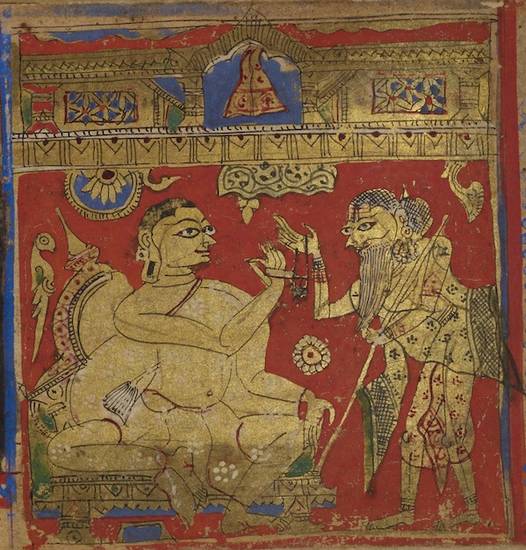
Kālaka with Śakra in disguise
Image by British Library © CC0 1.0 (Creative Commons Public Domain)
From the earliest times tales have been regarded as an essential part of teaching, for all types of audiences. The Jinas themselves recounted stories in their preaching. In the course of centuries, some simple anecdotes have developed into full-fledged works of fiction. Some characters who were just names meant to illustrate a notion have turned into heroes at the centre of novel-like works, undergoing ups and downs, losses and gains. In short, they have become figures that fully illustrate the concepts of karma and rebirth, and also inspiring heroes that hold the reader’s attention.
The most popular Jain heroes and heroines have been the starting point of numerous retellings. They also feature prominently in paintings in the manuscripts, which could be shown and used in festivals or temple-halls.
There are several good examples in manuscripts digitised on JAINpedia, especially the:
- Story of the Teacher Kālaka, often appended to the Kalpa-sūtra, which is connected with the Śvetāmbara festival of Paryuṣaṇ
- Story of Yaśodhara, held in the Wellcome Trust, which illustrates ahiṃsā
- Story of Śālibhadra, found in the British Library, shows the power of giving alms to Jain monks
- Story of Śrīpāla, closely associated with the worship of the siddhacakra
- Āditya-vāra-vrata-kathā in the British Library, a popular story among Digambaras, which relates to the results of observing or not observing the so-called Sunday’s vow.
Jain authors are also famous for their rewritings of non-Jain stories, which are part of the common Indian heritage. Good examples of such illustrated manuscripts digitised on JAINpedia are the :
- Story of Ḍholā and Marū, a folk legend popular in Rajasthan
- Story of Mādhavānala.
Hymns
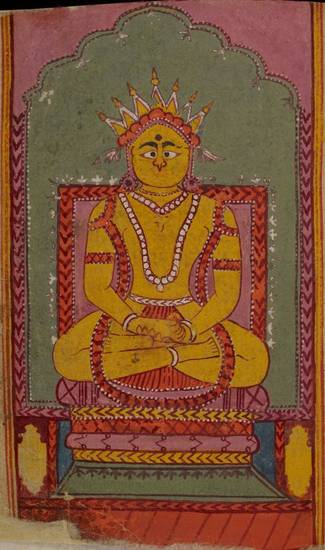
A Jina meditating, probably Supārśva
Image by British Library © CC0 1.0 (Creative Commons Public Domain)
Devotional songs are part of Jain daily religious practice. They have been composed in all the ancient and modern languages of India, including Prakrit, Sanskrit, Gujarati, Hindi and Tamil. Hymns combine text, rhythm and chanting, but also have a visual dimension in many instances.
This is often the case with the Bhaktāmara-stotra, one of the most famous Jain hymns. One JAINpedia manuscript has vignettes and graphical characteristics that make it unusual. Another one has different diagrams for each of the 48 stanzas of the text and indications about performance.
In addition, JAINpedia presents another well-known set of devotional songs with a strong visual element. A collection of hymns to each of the 24 Jinas, composed by the 17th-century writer and philosopher Yaśovijaya, has an image of every Jina.
Objects
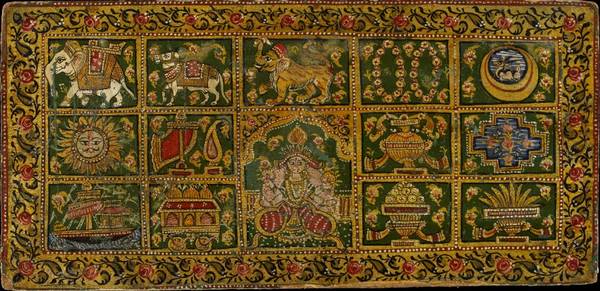
Fourteen auspicious dreams
Image by Victoria and Albert Museum © V&A Images/Victoria and Albert Museum, London
Manuscripts proper are not the only medium of teaching. Material culture in the form of various artefacts is also part of the Jain heritage. Some of these artefacts may be inscribed with text.
Remarkable items on JAINpedia are:
- two manuscript covers depicting the auspicious dreams, both held in the Victoria and Albert collections, under shelfmarks IS 20-1978 and IS 50-1983
- a V&A cloth painting showing the game of snakes and ladders, with elaborate captions, which illustrates the process of karma and rebirth
- a letter of invitation – vijñapti-patra – with paintings and a detailed text, which is a highlight of the British Library collections
- a victory banner featuring a variety of gods and goddesses, a striking piece in the V&A collections
- a maṇḍala with images of the 24 Jinas, which is an appropriate object for worship or remembrance
- a rare sūri-mantra-paṭa – special yantra used only by high-ranking Śvetāmbara monks – held in the collections of the Royal Asiatic Society.
Links
- Bhaktāmara-stotra – Digambara
-
YouTube provides a video of the original Sanskrit Bhaktāmara-stotra, accompanied by pictures of Jina figures. The Digambara version of 48 stanzas is sung by the Rajasthani classical singer Rattan Mohan Sharma.
- Bhaktāmara-stotra – Digambara text
-
The 48 Sanskrit verses of the Digambara version of the hymn are presented in Nagari and transliteration with English translation below, on a faculty private page on the Colorado State University website. The hymn is considered to be a masterpiece of Sanskrit poetry.
- Bhaktāmara-stotra – Śvetāmbara recitation
-
The original Sanskrit Bhaktāmara-stotra is recited by the Śvetāmbara monk Param Pujya Vijay Bhuwan Shekhar Surishwarji Maharaj. This 2010 YouTube video contains pages of an illustrated publication of the hymn, which is a masterpiece of Sanskrit poetry.
- Bhaktāmara-stotra – Śvetāmbara text
-
The HereNow4U website provides the Sanskrit text of the Śvetāmbara hymn in Nagari, English translation and word-to-word translation, accompanied by modern illustrations. There is also a glossary of Sanskrit terms.
To move to another verse, click on one of the arrows above the title or slide the button along the scroll bar.
- R̥ṣabha and Indra
-
A manuscript painting in the Los Angeles County Museum of Art shows Indra, king of the gods, taking the infant R̥ṣabhanātha or Lord R̥ṣabha, the first Jina, to Mount Meru for his ritual bath. The decorated elephant and canopy symbolise royalty while the lotus flowers are emblems of spiritual purity. The gods around blow trumpets and conches in celebration. A very popular Jain hymn of praise, the Bhaktāmara-stotra has been translated into many languages and illustrated numerous times.
- Mānatuṅga and the Bhaktāmara-stotra
-
HereNow4U provides a version of the tale of Mānatuṅga, composer of the very popular Bhaktāmara-stotra hymn. The Digambara story found here recounts how the power of the hymn frees Mānatuṅga from his chains.
- King puts a merchant down a well
-
JainSquare.com provides a story associated with the Bhaktāmara-stotra hymn. This tale, found in Guṇākara's famous 14th-century commentary, is associated with the first two verses of the hymn. Unfortunately, the level of English makes it difficult to understand in places.
https://jainsquare.wordpress.com/?s=Blessings+from+The+Goddess
- King Hemabrahma and Queen Hamesri
-
JainSquare.com provides a story associated with the Bhaktāmara-stotra hymn. This tale of King Hemabrahma and Queen Hamesri is associated with the ninth verse of the hymn. Unfortunately, the level of English makes it difficult to understand in places.
- Bhaktāmara-stotra – illustrated pages
-
The University of Michigan Museum of Art holds pages of a Digambara manuscript which Phyllis Granoff of Yale has identified as illustrated pages of a Digambara Bhaktāmara-stotra. Her 2010 article, 'Illustrating the Bhaktāmarastotra', can be seen on the HereNow4U website.
http://quod.lib.umich.edu/cgi/i/image/image-idx?type=bbaglist;view=bbthumbnail;bbdbid=796751910
- Bhaktāmara-stotra worship ritual
-
During the 2006 festival of Paryuṣaṇ, Jains take part in the rite of Bhaktāmara-stotra pūjā in London. This report from the HereNow4U website provides a first-hand account and pictures of the ceremony. The Bhaktāmara-stotra is one of the few Jain hymns to be the focus of ceremonial worship.
- Bhaktāmara-stotra ceremony
-
A first-hand illustrated report on the Bhaktāmara-pūjā or worship ritual, held in London in 2005, is provided on the HereNow4U website. The report and photographs show some stages of the Digambara ceremony, which is celebrated by the whole community. The Bhaktāmara-stotra is one of the few Jain hymns to be the centre of religious worship.
- Chanting the Bhaktāmara-stotra
-
On 20th April 2007 Jains in London spent 24 hours reciting the Bhaktāmara-stotra for the Akṣaya-tr̥tīyā festival. The hymn is one of the best-known Jain devotional songs and, like the Akṣaya-tr̥tīyā festival, is associated with Ṛṣabhanātha or Lord Ṛṣabha, the first Jina. This illustrated report by Hina Vora is on the HereNow4U website.
- Namaskāra-mantra and Bhaktāmara-stotra with yantras – part one
-
This YouTube slideshow features a recording of the Namaskāra-mantra followed by the Bhaktāmara-stotra, a famous Sanskrit hymn of praise to the first Jina, Ṛṣabha.;
Also known as the Navkār-mantra or Namokār-mantra, the Namaskāra-mantra is a very old mantra in Prakrit. It can be sung to different tunes and is chanted daily to honour the 'five types of beings worthy of worship' or Supreme Beings':
Bhaktāmara-stotra means Devoted Gods. This title comes from the first verse, which describes how all the gods offer homage to Ṛṣabha. The slideshow includes colour-tinted yantras and mantras to help listeners meditate.
This is the first of four parts of the Śvetāmbara hymn, which has 44 verses. This part contains stanzas 1 to 12.
http://www.youtube.com/watch?v=ZzJtiikKnh4
This YouTube slideshow features a recording of the Bhaktāmara-stotra, a famous Sanskrit hymn of praise to the first Jina, Ṛṣabha. The title Devoted Gods comes from the first verse, which describes how all the gods offer homage to Ṛṣabha. The slideshow includes colour-tinted yantras and mantras to help listeners meditate.
This is the first of four parts of the 44-verse Śvetāmbara hymn, covering stanzas 01 to 12
https://www.youtube.com/watch?v=ZzJtiikKnh4&list=PLE8A9751AC19A4277
- Bhaktāmara-stotra with yantras – part two
-
This YouTube slideshow features a recording of the Bhaktāmara-stotra, a famous Sanskrit hymn of praise to the first Jina, Ṛṣabha. The title Devoted Gods comes from the first verse, which describes how all the gods offer homage to Ṛṣabha. The slideshow includes colour-tinted yantras and mantras to help listeners meditate.
This is the second of four parts of the 44-verse Śvetāmbara hymn, covering stanzas 13 to 25.
- Bhaktāmara-stotra with yantras – part three
-
This YouTube slideshow features a recording of the Bhaktāmara-stotra, a famous Sanskrit hymn of praise to the first Jina, Ṛṣabha. The title Devoted Gods comes from the first verse, which describes how all the gods offer homage to Ṛṣabha. The slideshow includes colour-tinted yantras and mantras to help listeners meditate. The yantras in this part begin with the svastika, ancient Asian symbol of well-being and good fortune.
This is the third of four parts of the 44-verse Śvetāmbara hymn, covering stanzas 26 to 38.
- Bhaktāmara-stotra with yantras – part four
-
This YouTube slideshow features a recording of the Bhaktāmara-stotra, a famous Sanskrit hymn of praise to the first Jina, Ṛṣabha. The title Devoted Gods comes from the first verse, which describes how all the gods offer homage to Ṛṣabha. The slideshow includes colour-tinted yantras and mantras to help listeners meditate.
This is the last of four parts of the 44-verse Śvetāmbara hymn, covering stanzas 39 to 44.
- Bhaktamar Mahayantra
-
A 'great yantra' honouring the Bhaktāmara-stotra on the HereNow4U website. A very popular Jain hymn of praise, the Bhaktāmara-stotra is closely associated with mantras – auspicious syllables – and mystical diagrams – yantras. Reciting the mantras and meditating on the yantras is part of the Bhaktāmara-stotra worship ceremony. Each verse has developed its own mantra and yantra, but there are also yantras designed to be contemplated when chanting the whole hymn.
- Bhaktāmara temple
-
The Jinalaya website provides information about the Shri Bhaktamar Bhavya Mandir in Baruch, Gujarat. The temple is dedicated to the first Jina, Ṛṣabha, and the devotional song of the Bhaktāmara-stotra. The temple houses an image of the hymn's composer, Mānatuṅga, and the 44 stanzas of the Śvetāmbara version, as well as figures of the first Jina.
- Harsukhrai Temple
-
The HereNow4U website reprints a 1945 article on the Harsukhrai Temple at Dharmapura, Delhi, also called the Naya Mandir. The article describes and provides photographs of the Digambara temple, which features verses of the Bhaktāmara-stotra. The famous hymn of the Bhaktāmara-stotra is associated with miraculous powers that come from repeating its verses, especially the name of the first Jina, Ṛṣabha.
- Nemi decides to renounce
-
This illustrated page from a 15th-century manuscript of the Kalpa-sūtra is provided by the National Gallery of Australia. At the beginning of the section dealing with the 22nd Jina, Ariṣṭanemi, also called Nemi, the painting shows the famous episode of Prince Nemi's decision to renounce worldly life just before his wedding. He is so appalled by the distress of the animals due to be killed for his wedding feast that he decides to become a monk.
http://artsearch.nga.gov.au/Detail-LRG.cfm?View=LRG&IRN=147981&PICTAUS=TRUE
- Hariṇaigameṣin transfers the embryo
-
This rare palm-leaf page in the collections of the Philadelphia Museum of Art comes from an early 14th-century manuscript of the Śvetāmbara scripture of the Kalpa-sūtra. The picture illustrates the episode where the antelope-headed god Hariṇaigameṣin transfers the embryo of the Jina-to-be Mahāvīra from the brahmin lady Devānandā to the kṣatriya queen Triśalā.
http://www.philamuseum.org/collections/permanent/131608.html?mulR=656|4
- Mahāvīra renounces
-
This illustration is from a page of the Śvetāmbara scripture of the Kalpa-sūtra in the collections of the Philadelphia Museum of Art. It shows the last Jina, Mahāvīra, performing the rite of keśa-loca – ‘pulling out of the hair’ – which indicates indifference to the body. It is part of the initiation ceremony of dīkṣā, in which an initiate renounces the world and becomes a mendicant. He is watched by Śakra, king of the gods, who takes an active role in the lives of the 24 Jinas.
http://www.philamuseum.org/collections/permanent/105108.html?mulR=656|9
- A Jina renounces
-
This highly decorated page from a 15th-century manuscript of the Kalpa-sūtra is provided by the National Gallery of Australia. A young man performs the rite of keśa-loca – ‘pulling out of the hair’ – which indicates indifference to the body. It is part of the initiation ceremony of dīkṣā, in which an initiate renounces the world and becomes a mendicant. He is watched by Śakra, king of the gods who takes an active role in the lives of the 24 Jinas.
http://artsearch.nga.gov.au/Detail-LRG.cfm?IRN=177852&View=LRG
- Pārśva meditating
-
The National Gallery of Australia offers an elaborately illustrated page from a 15th-century manuscript of the Kalpa-sūtra. The 23rd Jina Pārśva sits in the lotus posture of meditation. He is easily identifiable from his seven-headed snake headdress.
http://artsearch.nga.gov.au/Detail-LRG.cfm?IRN=177853&View=LRG
- Kalpa-sūtra of Bhadrabāhu – Gallica Bibliothèque numérique
-
This manuscript of the Kalpa-sūtra is fully digitised on the Gallica Bibliothèque numérique website, part of the Bibliothèque Nationale de France (National Library of France) in Paris. Though the website is available in English, the information about the artefact is in French.
- +
- aAbhavya
- aAbhinandana
- aAbhiṣeka
- aĀcāra
- aĀcārāṅga-sūtra
- aĀcārya
- aAchalbhrata
- aAḍhāī-dvīpa
- aAdharma
- aAdho-loka
- aAdhyayana
- aAdvaita Vedānta
- aĀgama
- aAghātīya
- aAghātīya-karman
- aAgnibhuti
- aAgra
- aĀhāra
- aAhiṃsā
- aAhimsa Day
- aAjita
- aAjīva
- aAkampit
- aĀkāśa
- aAkbar the Great
- aAkṣaya-tṛtīyā
- aAlauddin Khalji
- aAlbert Einstein
- aAllah
- aAlms
- aĀlocanā
- aAloka-ākāśa
- aAmāri
- aAmbikā or Kūṣmāṇḍinī
- aAnagāra
- aAnanta
- aAnarthadaṇḍa
- aAnaśana
- aAnekānta-vāda
- aAṅga
- aAniconism
- aAnojjā
- aAntarāla
- aAntarāya-karma
- aAṇu
- aAṇu-vrata
- aAnukampā
- aAnuprekṣā
- aAnusvāra
- aApabhraṃśa
- aAparigraha
- aAra
- aĀrambha
- aĀrambhaja
- aĀratī
- aArdhamāgadhī Prākrit
- aArhaṃ
- aArhat
- aArśana-āvaraṇīya-karma
- aĀrta-dhyāna
- aĀryikā
- aĀryikā Jñānamati
- aĀśātanā
- aĀścarya
- aAscetic
- aAsceticism
- aAshram
- aAspiration
- aĀsrava
- aAṣṭa-maṅgala
- aAṣṭāpada
- aAstikāya
- aAstrolabe
- aAsura
- aAtheism
- aAticāra
- aAtiśayakṣetra
- aAtithisaṃvibhāgavrata
- aĀtma-vāda
- aĀtman
- aAuṃ
- aAurangzeb
- aAuspicious
- aAusterity
- aAvadhāna
- aAvadhi-jñāna
- aĀvaraṇī-yakarman
- aAvasarpiṇī
- aAvatāra
- aAvidyā
- aAxiom
- aĀyāga-paṭa
- aĀyambil
- aĀyu-karma
- aĀyurveda
- bBabur
- bBāhubali
- bBaladeva
- bBālāvabodha
- bBandha
- bBasadi
- bBazaar
- bBhadrankarvijay
- bBhagavant
- bBhaktāmara-stotra
- bBhakti
- bBhale
- bBharata
- bBhāṣā
- bBhāṣya
- bBhaṭṭāraka
- bBhāva
- bBhāva-pūjā
- bBhāvanā
- bBhavana-vāsin
- bBhavya
- bBhavyatva
- bBhaya
- bBhoga-bhūmi
- bBhogopabhoga
- bBodhi
- bBollywood
- bBrahmā
- bBrahma-deva
- bBrahmacārī
- bBrāhmaṇa
- bBraj Bhāṣā
- bBright fortnight
- bBritish Raj
- bBuddha
- bBuddhi-sagar
- bBuddhism
- bBuddhist
- cCaitya
- cCaityavāsin
- cCakravartin
- cCakreśvarī
- cCāmara
- cCandanā
- cCandragupta
- cCandraprabha
- cCanon
- cCāritra
- cCāritramohanīya-karman
- cCarũrī
- cCaste
- cCaturvidha-saṅgha
- cCaturviṃśati-stava
- cCāturyāma
- cCE
- cCelibacy
- cCha
- cChadmastha
- cChastity
- cCheda-sūtra
- cChristian
- cChristianity
- cClergy
- cCloning
- cColophon
- cCommentary
- cConch
- cConfession
- cCongregation
- cConsecration
- cCosmology
- cCremation
- cCrore
- cCult
- cCūrṇi
- dDādā-guru
- dDalit
- dDāna
- dDaṇḍa
- dDark fortnight
- dDarśana
- dDarśanamohanī-yakarman
- dDaśa-lakṣaṇa-parvan
- dDeity
- dDelhi Sultanate
- dDerāsar
- dDeśāvakāśika-vrata
- dDetachment
- dDevanāgarī
- dDevānandā
- dDevarddhi-gani
- dDevotee
- dDhamal
- dDhanuṣ
- dDhāra
- dDharma
- dDharma-dhyāna
- dDharma-sāgara
- dDharmastikaya
- dDhātakīkhaṇḍa
- dDholak
- dDhyāna
- dDiaspora
- dDig-vrata
- dDigambara
- dDīkṣā
- dDisciple
- dDīvālī
- dDivya-dhvani
- dDNA
- dDoctrine
- dDogma
- dDonor
- dDoṣa
- dDravya
- dDravya-pūjā
- dDrone
- dDuṣamā
- dDuṣamā-duṣamā
- dDuṣamā-suṣamā
- dDveṣa
- dDvīpa
- eEast India Company
- eEightfold Path
- eEkānta-vāda
- eEkendriya
- eElder
- eElders
- eEschatology
- eEtc up to
- fFarmān
- fFast
- fFatehpur Sikri
- fFestival
- fFestschrift
- fFiruz Shah
- fFly-Whisks
- fFolio
- fFour Noble Truths
- gGaccha
- gGaṇa
- gGaṇadhara
- gGanadharavada
- gGaṇeśa
- gGaṇin
- gGarba
- gGarbha
- gGarbha-gṛha
- gGaruḍa
- gGati
- gGene
- gGenomics
- gGhātī-yakarman
- gGhātīya
- gGhaznavid
- gGhiyasuddin Tughlaq
- gGhurid
- gGloss
- gGotra-karma
- gGujarāt
- gGujarati
- gGuṇa
- gGuṇa-sthāna
- gGuṇa-vrata
- gGupti
- gGuru
- gGuruṇī
- hHagiography
- hHajj
- hHaṃsa
- hHaribhadra
- hHariṇaigameṣin
- hHasta
- hHeresy
- hHiṃsā
- hHindi
- hHindu
- hHinduism
- hHīravijaya
- hHoroscope
- hHrīṃ
- hHumayun
- hHymn
- iIconoclasm
- iIconography
- iIdol
- iIndian Independence
- iIndology
- iIndra
- iIndrabhūti Gautama
- iIndriya
- iInitiation
- iIntercession
- iInvocation
- iIQ
- iIslam
- iIslamicate
- iIṣṭadevatā
- iĪśvara
- jJagat
- jJahangir
- jJain
- jJaina Devanāgarī
- jJaina Śaurasenī
- jJaina-dharma
- jJainaśāsana
- jJainness
- jJaisalmer
- jJamāli
- jJambū-dvīpa
- jJames Burgess
- jJanma
- jJanma-kalyāṇa
- jJarā
- jJāti
- jJina
- jJina-āgama
- jJina-bhavana
- jJina-bimba
- jJina-mātā
- jJinacandra-sūri
- jJinadatta
- jJinaprabha
- jJīva
- jJñāna
- jJñāna-āvaraṇīya-karma
- jJñāna-āvarṇiya
- jJñānsundar
- jJyotiṣka
- kKāla
- kKālakācārya-kathā
- kKālidāsa
- kKalpa-sūtra
- kKalpa-vṛkṣa
- kKalyāṇaka
- kKalyanvijay
- kKamaṇḍalu
- kKamaṭha
- kKarma
- kKarma-bhūmi
- kKarma-grantha
- kKarma-prakṛti
- kKarma-vāda
- kKarmon
- kKarnataka
- kKaṣāya
- kKathā
- kKāvya
- kKāya
- kKāyotsarga
- kKeśa-loca
- kKetu
- kKevala-jñāna
- kKevalin
- kKhalji
- kKharatara-gaccha
- kKnowledge
- kKriyā
- kKriyā-vāda
- kKṛṣṇa
- kKṣamā-śramaṇa
- kKṣapakaśreṇi
- kKṣatriya
- kKṣullaka
- kKulakara
- kKundakunda
- kKunthu
- lLabdhi
- lLaity
- lLakh
- lLāñchana
- lLands of Action
- lLaukāntika
- lLavaṇa-samudra
- lLeśyā
- lLiṅga
- lLinguistics
- lLoka
- lLoka-ākāśa
- lLoka-puruṣa
- lLoka-vāda
- lLotus
- lLotus lake
- mMadhya-loka
- mMahā-videha
- mMahā-vrata
- mMahābhārata
- mMahāmastakābhiṣeka
- mMāhārāṣṭra
- mMāhārāṣṭrī Prākrit
- mMahattarā Yākinī
- mMahāvīr Jayantī
- mMahāvīra
- mMakāra
- mMakkhali Gośāla
- mMalli
- mMāna-stambha
- mManaḥ-paryāya-jñāna
- mMaṇḍala
- mMaṇḍapa
- mMandit
- mMaṅgala
- mMantra
- mMantras
- mManuṣya-loka
- mMarāṭhī
- mMārgaṇā
- mMartyr
- mMarudevī
- mMaṭha
- mMati-jñāna
- mMauryaputra
- mMecca
- mMendicant lineage
- mMetarya
- mMiracle
- mMithyādṛṣṭi
- mMohandas Gandhi
- mMohanīya-karma
- mMokṣa
- mMonastic order
- mMonasticism
- mMonk
- mMonotheism
- mMosque
- mMount Meru
- mMount Sammeta
- mMṛgāvatī
- mMughal
- mMuhammad
- mMuhammad bin Tughlaq
- mMuhpattī
- mMūla-sūtra
- mMūlaguṇa
- mMumbaī
- mMuni
- mMunisuvrata
- mMurad Bakhsh
- mMūrti-pūjaka
- mMuslim
- mMysticism
- nNābhi
- nNāga-kal
- nNāgapurīya Tapā-gaccha
- nNāgarī
- nNāma-karma
- nNamaskāra-mantra
- nNami
- nNandīśvara-dvīpa
- nNandivardhana
- nNandyāvarta
- nNāraka
- nNāraki
- nNasalisation
- nNātha
- nNavrātrī
- nNaya-vāda
- nNemi
- nNidāna
- nniggaṃthāṇa vā 2
- nniggaṃtho vā 2
- nNigoda
- nNihnava
- nNikṣepa
- nNirgrantha
- nNirjarā
- nNirvāṇa
- nNiryukti
- nNiṣidhi
- nNitya
- nNiyati
- nNo-kaṣāya
- nNudity
- nNun
- oOcean of milk
- oOmniscience
- oOrdination
- ppa°
- pPadmaprabha
- pPadmāsana
- pPadmāvatī
- pPādukā
- pPalanquin
- pPalette
- pPañca-muṣṭi
- pPāṇḍava
- pPaṇḍit
- pPandit Dalsukh D. Malvania
- pPandit Sukhlalji
- pPāṇipātra
- pPāpa
- pParamātman
- pParameṣṭhin
- pPāraṇā
- pParigraha
- pPariṇāma
- pParīṣaha
- pParokṣa
- pPārśva
- pPārśvanātha
- pParyāya
- pParyuṣaṇ
- pPaṭa
- pPatan
- pPātra
- pPenance
- pPersian
- pPhala
- pPhilology
- pPicchikā
- pPilgrimage
- pPīr
- pPolymath
- pPoṣadha
- pPossession
- pPothī
- pPrabhas
- pPradakṣiṇā
- pPradeśa
- pPrākāra
- pPrakīrṇaka-sūtra
- pPrākrit
- pPramāda
- pPramukhā
- pPrati-vāsudeva
- pPratikramaṇa
- pPratimā
- pPratiṣṭhā
- pPratyākhyāna
- pPratyakṣa
- pPravacana
- pPrāyaścitta
- pPrayer
- pPre-modern
- pPreach
- pPredestination
- pProtestant
- pProvenance
- pPudgala
- pPūjā
- pPujārī
- pPukharavara-dvīpa
- pPuṇya
- pPūrva
- pPuṣkara-dvīpa
- pPuṣpadanta
- pPyre
- qQur’an
- rRāga
- rRāhu
- rRainy season
- rRajasthan
- rRajasthani
- rRājimatī
- rRajoharaṇa
- rRajput
- rRāma
- rRāmāyaṇa
- rRangoli
- rRās-garbā
- rRasa
- rRathanemi
- rRatna-traya
- rRātri-bhojana
- rRaudra-dhyāna
- rRecto
- rRelic
- rRenunciation
- rRetroflex
- rRevatī
- %Ṛg-veda
- rRite
- rRosary
- %Ṛṣabha
- %Ṛṣabhanātha
- rRupee
- sSaciyā Mātā
- sSādhu
- sSādhvī
- sSāgāra
- sSaint
- sŚaivaism
- sŚaka-saṃvat
- sSallekhanā
- sŚalya
- sSamacatuṣṭha
- sSamādhimaraṇa
- sSamaṇi
- sSāmarambha
- sSamavasaraṇa
- sSāmāyika
- sSaṃbhava
- sSamiti
- sSaṃjñā
- sSaṃkalpaja
- sSaṃsāra
- sSamudghāta
- sSaṃvara
- sSaṃvega
- sSamyak-cāritra
- sSamyak-darśana
- sSamyak-jñāna
- sSamyaktva
- sSaṃyama
- sSanctuary
- sSandalwood
- sSaṇgha
- sSanskrit
- sSant
- sŚānti
- sSapta-bhaṅgi-naya
- sSārambha
- sSarasvatī
- sSarvajña
- sSāsan-devi
- sŚāsana-devatā
- sŚāstra
- %Ṣaṭ-jīvanikāya
- sSatī
- sSatīmātā
- sSatya
- sSchism
- sScribe
- sScripture
- sSect
- sSecularism
- sŚenāī
- sSermon
- sŚeṣavatī
- sSevā
- sSeven fields of donation
- sShah Jahan
- sShantidas Jhaveri
- sShrine
- sSiddha
- sSiddha-śilā
- sSiddhacakra or Navadevatā
- sSiddhānta
- sSiddhārtha
- sSiddhi
- sSikh
- sSikhism
- sŚikṣā-vrata
- sŚīla
- sSin
- sSindh
- sŚītala
- sŚiva
- sSkandha
- sSomanatha
- sŚraddhā
- sŚramaṇa
- sŚrāvaka
- sŚrāvakācāra
- sŚrāvikā
- sŚreyāṃsa
- sŚrī
- sŚrīvatsa
- sŚruta-jñāna
- sŚruta-pañcamī
- sSthānaka-vāsin
- sSthāpanācārya
- sSthāvara
- sSthavira
- sSthiti
- sStrīmukti
- sStūpa
- sSubcontinent
- sSudarshana
- sŚuddhi
- sSudharma
- sŚūdra
- sSufism
- sSukha
- sŚukla-dhyāna
- sSulasā
- sSultan
- sSumati
- sSundarśrī
- sSupārśva
- sSūri
- sSuṣamā
- sSuṣamā-duṣamā
- sSuṣamā-suṣamā
- sSūtra
- sSuyam me ausam! Tenam bhagavaya evamakkhayam
- sSvādhyāya
- sSvāhā
- sSvastika
- sŚvetāmbara
- sŚvetāmbara Terāpanthin
- sŚvetāmbaras
- sSwan
- sSyād-vāda
- tTabla
- tTantra
- tTapā-gaccha
- tTapas
- tTāraṇ Svāmī Panth
- tTattva
- tTattvārtha-sūtra
- tTemple
- tTemple-city
- tThe Enlightenment
- tTheology
- tThree worlds
- %Ṭīkā
- tTilaka
- tTīrtha
- tTīrthaṃkaranāma-karman
- tTīrthankara
- tTransliteration
- tTrasa
- tTrasa-nāḍī
- tTriśalā
- tTriṣaṣṭi-śalākā-puruṣa-caritra
- tTti bemi
- tTughlaq
- tTunk
- uUdumbara
- uUniversal History
- uUpādhyāya
- uUpāṅga
- uUpaniṣads
- uUpāsaka
- uUpasarga
- uUpāśraya
- uŪrdhva-loka
- uUtsarpiṇī
- uUttarādhyayana-sūtra
- vVāhana
- vVaimānika
- vVairāgya
- vVaiṣṇava
- vVaiśramaṇa
- vVaiśya
- vValabhī
- vVanaspatikāya
- vVandana
- vVaṇik
- vVarṇa
- vVāsudeva
- vVāsupūjya
- vVayubhūti
- vVeda
- vVedanīya-karma
- vVegetarianism
- vVehicle
- vVernacular
- vVerso
- vVidyā
- vVidyā-devī
- vVihāra
- vVijñapti-patra
- vVikrama-saṃvat
- vVikṛti
- vVimala
- vVinaya
- vVipāka
- vVirji Vora
- vVirodhaja
- vVīrya
- vVisarga
- vViṣṇu
- vVītarāga
- vVizier
- vVotive
- vVow
- vVrata
- vVS
- vVyakta
- vVyantara
- vVyasana
- yYakṣa
- yYakṣī
- yYantra
- yYaśoda
- yYaśovijaya
- yYati
- yYātrā
- yYoga
- yYoginī
- yYojana


